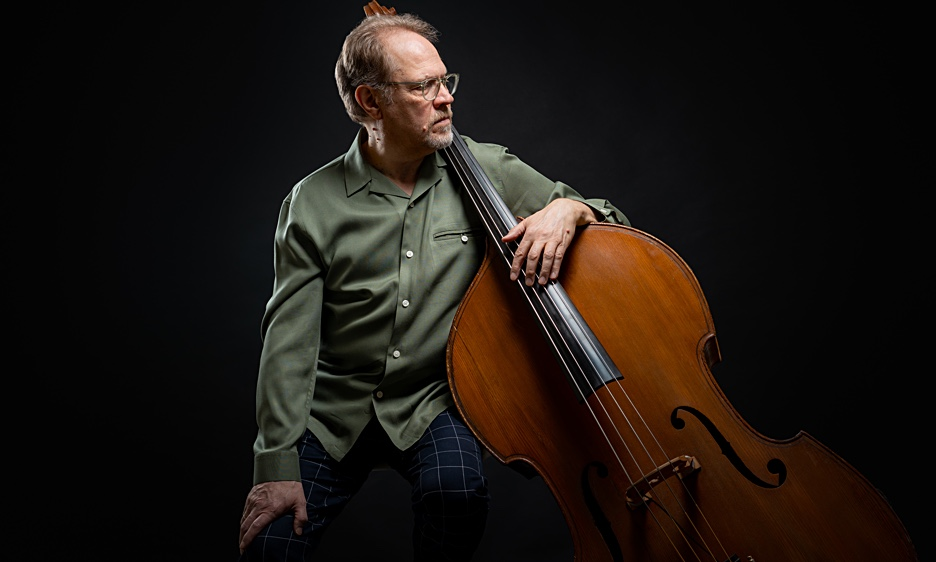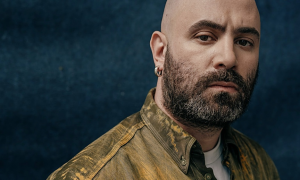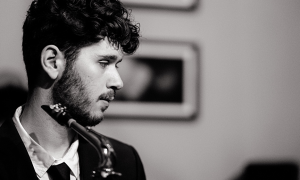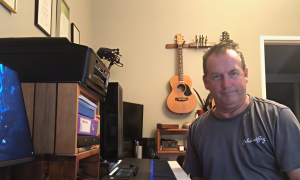Home » Jazz Articles » Take Five With... » Take Five with Bassist Bruno Råberg
Take Five with Bassist Bruno Råberg

This is bass playing at its most enchanting.
—Ian Patterson, All About Jazz
Meet Bruno Råberg
Bruno Råberg is an internationally renowned bassist and composer. Since coming to the US from his native Sweden in 1981, he has made 13 recordings as a leader, about 30 as a sideman, and has performed with numerous world-class artists, including Kris Davis, Terri Lyne Carrington, Jerry Bergonzi, George Garzone, Kenny Werner, Sam Rivers, Tony Malaby, Bill Pierce, Donny McCaslin, Billy Hart, Bob Moses, Mick Goodrick, Ben Monder, Bruce Barth, Jim Black, Matt Wilson, Ted Poor, Bob Mintzer and Mike Mainieri. He currently leads several constellations of his own, notably Bruno Råberg Trio and the Triloka Ensemble. At 20, Råberg was drafted by Swedish trombone virtuoso Eje Thelin and spent the ensuing years performing and recording with renowned Swedish and European artists such as Monica Zetterlund, Zbigniew Seifert. In 1981, Råberg left his performing career in Europe to come to the USA, thanks to a scholarship to the New England Conservatory in Boston. There he studied with Miroslav Vitous, Mick Goodrick, George Russell and Bob Moses. Råberg has been a professor at Berklee College of Music in Boston since 1986 and teaches in the prestigious Berklee Global Jazz Institute, led by pianist Danilo Pérez.Instruments:
Acoustic bass primarily but also electric bass and piano, the latter mainly for composing and when teaching.Teachers and/or influences?
I studied three years with Miroslav Vitous at New England Conservatory (1981-84). Major influences are Paul Chambers, Scott LaFaro, Dave Holland, Palle Danielsson, Gary Peacock, Ron Carter, Charlie Haden, Scott Colley and many many more.I knew I wanted to be a musician when...
My main passion and interest has always been to play music. I don't have any specific moment that I can remember other then hearing John Coltrane's "Giant Steps" at age 15 but I already knew I just wanted to play then.Your sound and approach to music.
Big question. If you really hear with your inner imagination what you will be playing and are able to connect that with your instrument, your sound will reveal itself. It might not happen overnight. When we learn how to play we imitate our heroes but sooner or later our own sound will evolve.Your teaching approach
The short version is that I always try to find out two things with each new student. 1. What does the student need in terms of the basics? What bad habits and other technical aspects are limiting the student's ability to express themselves. 2. What excites the student? What information/activity will make the student run home with a desire to practice?Road story: Your best or worst experience
This is just a funny story. When I was with Swedish jazz group Corpo we had a gig in Hammerfest Norway. When arriving at the hotel we looked in the local paper and found a review of the gig we hadn't played yet. It said we sounded pretty good.Your favorite recording in your discography and why?
It's always the latest so Look Inside [Orbis Music, 2023] my new recording of solo bass.What do you think is the most important thing you are contributing musically?
Hopefully I am able to speak with my own voice through my instrument and make the listener be in the present moment.Did you know...
I started on accordion playing Swedish folk music, then blues guitar and harmonica and eventually both electric and acoustic bass. The first jazz album I bought was:
Con-Soul and Sax by Wild Bill Davis and Johnny Hodges with Milt Hinton bass.Music you are listening to now:
Kris Davis: Aeriol Piano (Clean Feed)Craig Taborn: Shadow Plays (ECM) Eric Dolphy Quintet: Outward Bound (New Jazz 823)
Ralph Towner: At First Sight (ECM)
Desert Island picks:
The albums listed here had some very significance during certain times in my life.Miles Davis Quintet: The Sorcerer (CBS)
Donald Fagen: The Nightfly (Warner Records)
John Lennon: Double Fantasy (Geffen)
Bill Evans Trio: Sunday at the Village Vanguard (Riverside)
Jali Nyama Suso: African Journey (Music Republic)
How would you describe the state of jazz today?
Jazz is always evolving, but right now there is too much emphasis on technical skill and on perfection. I think there's a whole area of being able to develop more a spiritual and emotional contact and connection with the listener that we've just began to explore.What are some of the essential requirements to keep jazz alive and growing?
There has to be a local thriving scene with musicians of all levels participating. I'd say that is just as important as big star-studded jazz festivals. When I came to Stockholm in 1974 to join trombonist Eje Thelin's group, I would hear legendary bassist Palle Danielsson and pianist Bobo Stenson play all the time. They were just into playing as much as possible and in many different bands and situations. This was immensely important to my development as a musician.What is in the near future?
I am booking solo bass concerts for the fall and a European tour for spring 2024, also for solo bass mainly. Back in January I recorded my Bruno Råberg Tentet project which is for six horns and four rhythm sections. It features pianist Kris Davis and saxophonist Walter Smith III along with Nate Radley guitar, Allan Chase saxophones, Anastassiya Petrova B3 organ, Charlotte Lang bass clarinet and others. The music is all original compositions and will be released in spring 2024.What is your greatest fear when you perform?
That my pants will slip off.What song would you like played at your funeral?
John Coltrane's "Resolution" really, really loud.What is your favorite song to whistle or sing in the shower?
Any of Eliot Carter's string quartets, the viola part.By Day:
Professor at Berklee College of Music, Boston.If I weren't a jazz musician, I would be a:
I think I'd be a chef, a linguistic scholar or a hole poker of Swiss cheese.If I could go back in time and relive an experience, what would it be?
Hearing Cecil Taylor at the Ljubljana Jazz Festival in 1975.Tags
Take Five With...
bruno raberg
AAJ Staff
Miroslav Vitous
Paul Chambers
Scott LaFaro
Dave Holland
Palle Danielsson
Gary Peacock
Ron Carter
Charlie Haden
Scott Colley
John Coltrane
Wild Bill Davis
Johnny Hodges
Milt Hinton
Kris Davis
Craig Taborn
Eric Dolphy
Ralph Towner
Miles Davis
Donald Fagen
John Lennon
Bill Evans
Bobo Stenson
Walter Smith III
nate radley
Allan Chase
Anastassiya Petrova
Charlotte Lang
Cecil Taylor
Mick Goodrick
PREVIOUS / NEXT
Bruno Raberg Concerts
Support All About Jazz
 All About Jazz has been a pillar of jazz since 1995, championing it as an art form and, more importantly, supporting the musicians who make it. Our enduring commitment has made "AAJ" one of the most culturally important websites of its kind, read by hundreds of thousands of fans, musicians and industry figures every month.
All About Jazz has been a pillar of jazz since 1995, championing it as an art form and, more importantly, supporting the musicians who make it. Our enduring commitment has made "AAJ" one of the most culturally important websites of its kind, read by hundreds of thousands of fans, musicians and industry figures every month.























